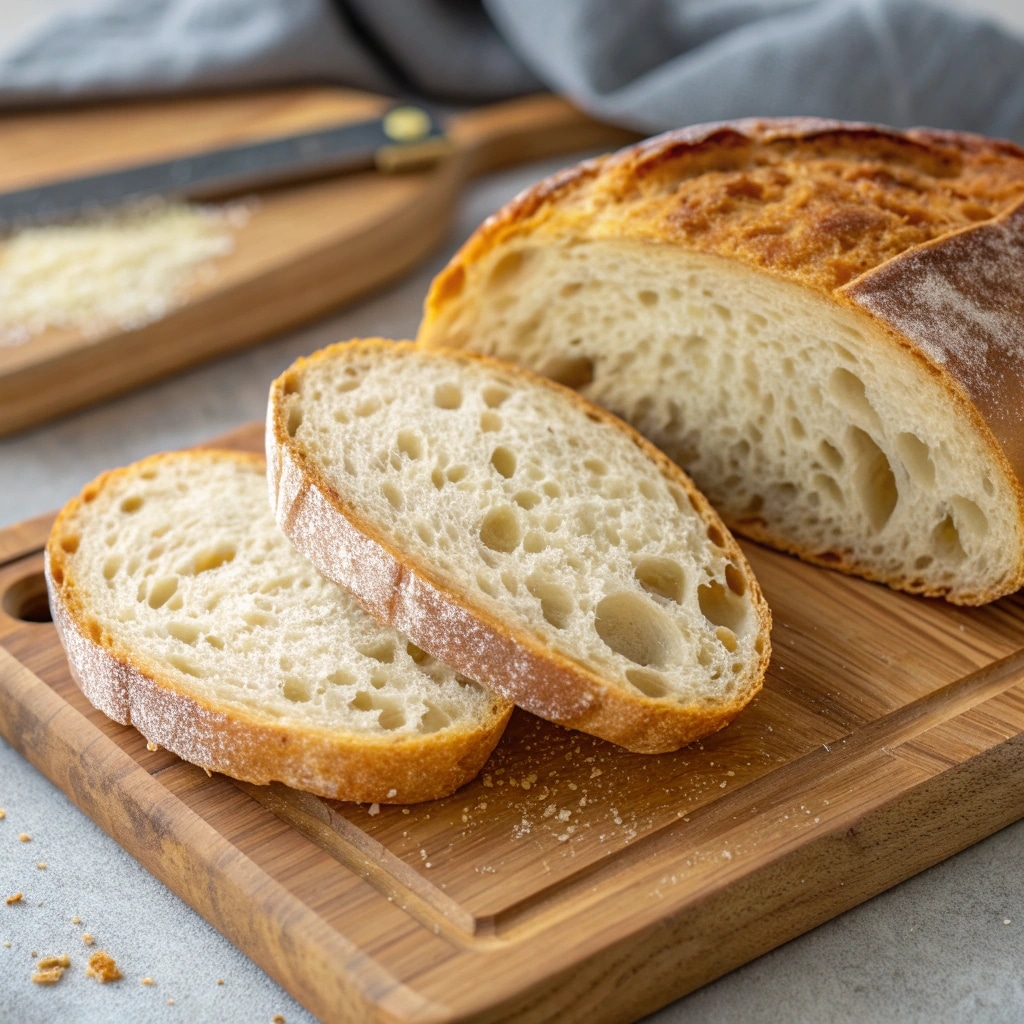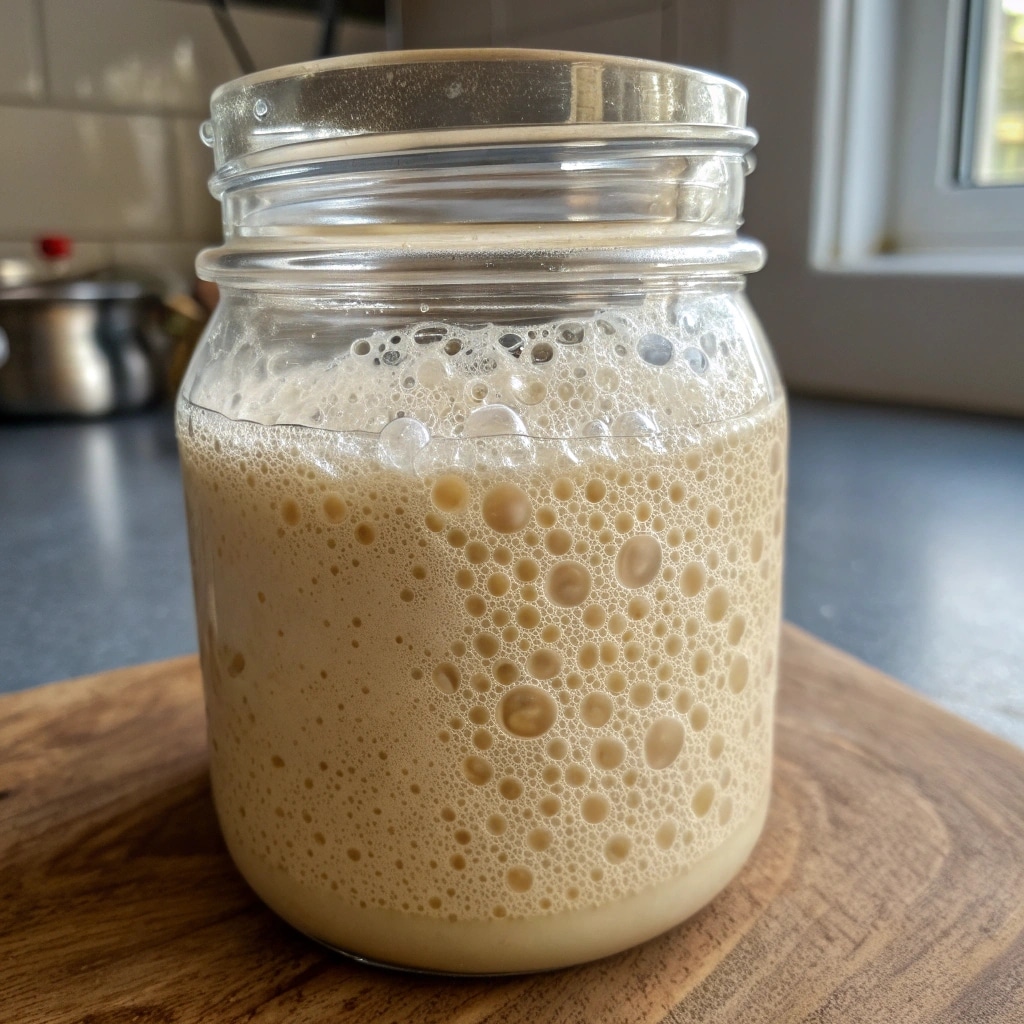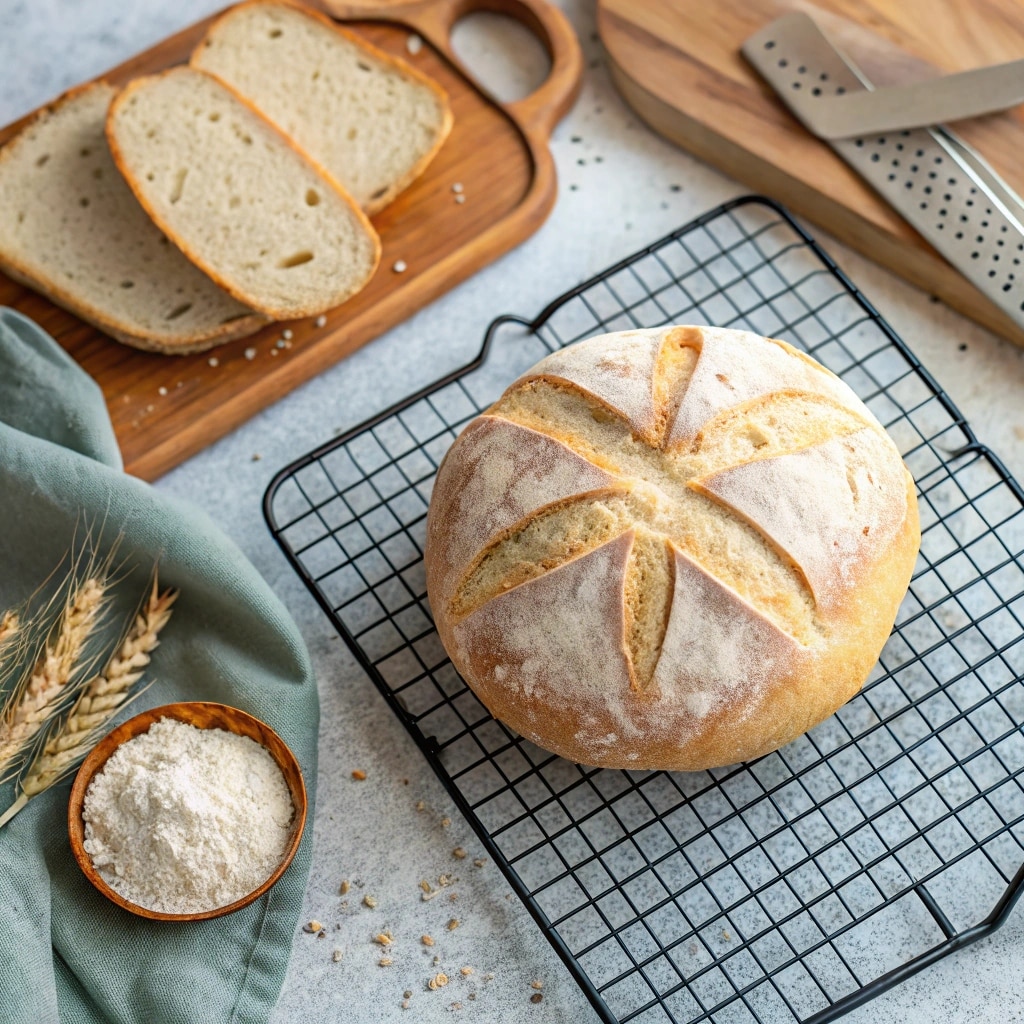If you’ve ever asked yourself is sourdough bread gluten free, you’re not alone. This question has been buzzing for years in kitchens, bakeries, and health circles. The short answer? Not always. While sourdough fermentation can reduce gluten and other compounds that trigger digestive discomfort, it doesn’t remove gluten completely. That means traditional wheat-based sourdough is not safe for those with celiac disease.

When I first baked bread in my grandma’s kitchen, I believed fermentation was magical enough to “fix” flour. The truth is, sourdough’s long fermentation makes it easier on digestion, supports gut health, and lowers glycemic impact—but it still contains gluten unless baked with certified gluten-free flours. For anyone with celiac or severe gluten sensitivity, choosing certified gluten-free sourdough bread or making it yourself is the only safe route. Let’s dive deeper into how sourdough works, what makes it different, and why gluten still matters.
Table of Contents
Understanding Sourdough Bread
What is sourdough bread?
At its core, sourdough is a simple mix of flour, water, and a sourdough starter—a living culture of wild yeasts and lactic acid bacteria. These microorganisms give sourdough its tangy flavor, chewy crumb, and rustic crust. Unlike breads baked with commercial yeast, sourdough develops naturally, often fermenting for 12–24 hours. If you’re just beginning, learning how to keep your starter alive is key. That’s why I always point readers to my feeding sourdough starter guide for step-by-step help.
How is sourdough different from regular bread?
The big difference is time. Regular yeast breads rise quickly in just a couple of hours, while sourdough ferments slowly, allowing enzymes to break down starches and proteins. This process softens the structure of gluten proteins and reduces fermentable carbs like fructans, which can ease digestion for some people. For bakers looking to push their skills, recipes like my sourdough baguette recipe show how versatile this ancient bread can be. And if you want something sweeter, try baking sourdough cinnamon rolls—they’re fluffy, tangy, and a perfect way to appreciate natural fermentation, gluten or not.
Sourdough vs. Regular Yeast Bread
If you’ve ever asked is sourdough bread gluten free compared to regular yeast bread, the table below makes the differences clearer. While sourdough fermentation does reduce gluten, it doesn’t remove it entirely—making it easier for some to digest but still unsafe for celiac disease.
| Feature | Sourdough Bread | Regular Yeast Bread |
|---|---|---|
| Leavening Agent | Wild yeast & lactic acid bacteria | Commercial yeast |
| Fermentation Time | 12–24+ hours | 1–3 hours |
| Texture & Flavor | Tangy, chewy, hearty | Mild, soft, light |
| Gluten Breakdown | Partially degraded | Minimal |
What Is Gluten—and Why It Matters
Defining gluten in simple terms
When we ask is sourdough bread gluten free, the answer depends on understanding what gluten actually is. Gluten is a natural protein found in wheat, barley, and rye. Think of it as the glue that holds bread together. It’s what gives dough its stretch and bakes into that soft yet elastic structure we love. Without gluten, bread would crumble apart instead of rising tall and airy.
Why gluten matters for sourdough
Here’s where sourdough gets interesting: its long fermentation doesn’t magically erase gluten. Instead, wild yeasts and lactic acid bacteria partially break down the protein chains. That’s why sourdough often feels easier to digest compared to fast-risen white bread. I remember baking my first boule and noticing how the crumb was chewy yet gentle, not dense like some whole wheat loaves. But even with that softer texture, gluten proteins remain present.
For people with celiac disease, even a trace amount of gluten—anything above 20 parts per million—is unsafe. That means a wheat-based sourdough, no matter how slowly it’s fermented, still contains gluten. If you’re managing gluten sensitivity or experimenting with different grains, you might enjoy recipes that adapt sourdough methods using safe flours. For example sourdough bread can be modified with buckwheat or rice flour to create a satisfying gluten-free sourdough bread alternative.
The key takeaway
Gluten gives bread structure and elasticity, and fermentation only weakens it slightly. That’s why sourdough can feel lighter and more digestible for some but remains unsafe for celiac disease. Gluten isn’t the enemy in every case—it’s simply a protein that behaves differently in different bodies. For some, sourdough’s natural fermentation makes it more tolerable; for others, even the smallest crumb is too much.
Can Fermentation Reduce Gluten?
The science behind fermentation
A big reason people wonder is sourdough bread gluten free is because fermentation changes how bread works in the body. When flour, water, and starter ferment slowly, wild yeasts and lactic acid bacteria produce acids and enzymes that partially break down gluten proteins. This process also reduces fermentable carbs like fructans. That’s why many people with sourdough gluten sensitivity say they feel better eating long-fermented bread compared to standard white loaves.
Does fermentation make sourdough gluten free?
The short answer is no. Fermentation weakens gluten proteins but doesn’t remove them fully. Studies from Gluten Free Watchdog prove that wheat-based sourdough remains above the FDA’s gluten-free threshold of 20 ppm. If you ask is sourdough bread gluten free enough for celiac disease, the clear answer is no—it’s not sourdough celiac safe. I learned this when I baked a 24-hour fermented boule for a friend with celiac. It looked beautiful, but it wasn’t safe.
Why fermentation still matters
Although fermentation doesn’t yield fully gluten-free sourdough bread, it still transforms bread in valuable ways. It improves mineral absorption, supports gut health, lowers glycemic impact, and adds that signature tangy depth. For people with mild gluten sensitivity, sourdough may feel more tolerable. But when gluten must be avoided entirely, only certified gluten-free sourdough is safe.
Practical tip for home bakers
If you love sourdough and want the benefits of fermentation without the gluten, use gluten-free flours and a dedicated starter. So if you’re still asking is sourdough bread gluten free when made at home, remember: only loaves baked with gluten-free flour and starter truly qualify.

Is Sourdough Safe for Celiac Disease?
If you’ve asked yourself is sourdough bread gluten free enough for celiac disease, the answer is simple: no. Regular wheat-based sourdough, no matter how long it ferments, still contains gluten proteins. Research by Gluten Free Watchdog confirms that fermentation does not reduce gluten to safe levels. A loaf must test below 20 ppm to qualify as gluten-free, and wheat sourdough rarely does. That means sourdough made with traditional flours is not sourdough celiac safe.
Why celiac safety matters
For someone with celiac, even small crumbs of gluten can damage the intestinal lining—even if symptoms don’t appear right away. Beyond Celiac, a leading research and advocacy group, has stated that eating wheat-based sourdough is still harmful for celiac patients, regardless of whether discomfort is felt. This is why certified gluten-free sourdough bread is the only option for those managing celiac disease.
My own baking lesson
When I first started baking sourdough, I wanted to believe that fermentation made my boules safe for everyone. I baked long-fermented loaves and shared them with friends, only to later learn that celiac disease doesn’t forgive—even the tiniest trace of gluten can cause lasting harm. That experience pushed me to explore gluten-free flours and build recipes that are truly safe.
The takeaway for celiac bakers
So, is sourdough bread gluten free enough for celiac safety? No—unless it’s made with certified gluten-free flour and a dedicated starter. Always check labels carefully, avoid bakery loaves unless clearly certified, and consider baking your own at home. That way, you control the ingredients, the fermentation, and the environment—making your sourdough not only delicious but safe.

Comparing Sourdough to Other Breads
Which breads contain the least gluten?
A common debate is is sourdough bread gluten free compared to rye or wheat bread? The truth is, all wheat-based breads contain gluten. Sourdough has less active gluten thanks to fermentation, but it’s still not safe for celiac.
Sourdough vs. whole wheat, rye, and white bread
When people ask is sourdough bread gluten free when compared with whole wheat, the answer remains no. White bread has gluten, whole wheat has even more, and rye contains gluten too. Sourdough may be easier for those with sourdough gluten sensitivity, but only certified gluten-free sourdough is safe.
Gluten Levels in Different Breads
Many readers ask is sourdough bread gluten free compared to other common breads like rye or whole wheat. The table below highlights gluten content and digestibility differences so you can see how sourdough fits in.
| Bread Type | Gluten Content | Digestibility |
|---|---|---|
| White Bread | High | Low (quick rise) |
| Whole Wheat Bread | Very High | Moderate (more fiber, more gluten) |
| Rye Bread | Moderate to High | Dense, harder to digest |
| Wheat Sourdough | Moderate (partially degraded) | Higher (fermented, gentler for some) |
| Gluten-Free Sourdough | None | Safe for celiac & sensitivities |
What About Gluten Sensitivity (NCGS)?
How sourdough affects gluten sensitivity
For non-celiac gluten sensitivity, the question often is is sourdough bread gluten free enough to try safely? The answer depends on your body. Fermentation reduces gluten and fructans, which may ease digestion for some, but wheat sourdough still contains gluten.
Why responses vary
Sourdough isn’t fully gluten-free, but many people with sourdough gluten sensitivity say it’s easier on their stomach than regular white bread. Still, when asked is sourdough bread gluten free for strict diets, the safe answer is no.
Potential benefits beyond gluten
Although sourdough isn’t fully sourdough celiac safe, it does offer benefits beyond gluten reduction. Long fermentation lowers glycemic impact, supports gut health through beneficial acids, and creates complex flavor. Some researchers even describe it as a probiotic bread because of its natural fermentation. For many with NCGS, this means sourdough isn’t just easier to digest—it may also support better overall digestion.
Practical advice for NCGS eaters
If you’re curious about sourdough but sensitive to gluten, try small amounts of long-fermented bread and pay attention to how your body reacts. And remember: even if sourdough feels easier, it isn’t gluten-free sourdough bread unless it’s made with certified gluten-free flours and a dedicated starter. That’s the only way to make sure your loaf is completely safe.
Is Sourdough Bread Gluten Free FAQs
What kind of bread has the least gluten?
People often ask is sourdough bread gluten free enough to be the lowest-gluten bread? Among wheat breads, yes—sourdough has less active gluten, but it is not gluten-free.
Is sourdough bread inflammatory?
Some wonder is sourdough bread gluten free and anti-inflammatory? It may feel gentler, but wheat sourdough is not gluten-free and may still trigger inflammation in sensitive people.
Is 100% sourdough gluten-free?
A common question is is sourdough bread gluten free if it’s 100% sourdough? No. “100% sourdough” means no commercial yeast, not gluten-free.
Is sourdough the healthiest bread?
Many ask is sourdough bread gluten free and the healthiest choice? It’s healthier for digestion, but not gluten-free unless made with certified flours.
Is gluten-free sourdough easy to make at home?
Yes. But when bakers ask is sourdough bread gluten free if baked at home, the answer depends on the flour. Only certified gluten-free flours make it safe.
Final Toughts About Is Sourdough Bread Gluten Free
So, is sourdough bread gluten free? The answer is clear: traditional wheat-based sourdough is not gluten-free. Fermentation does reduce gluten and can make sourdough easier to digest for some, but it never lowers gluten to the safe levels required for people with celiac disease. That’s why sourdough made with wheat is not sourdough celiac safe.
Baking sourdough has taught me that bread is more than food—it’s patience, tradition, and care in every bite. Whether you’re gluten-free or not, sourdough offers a connection to slow, mindful baking. Just remember: safety comes first. If you need gluten-free, make sure your sourdough truly is.
Follow me on Facebook and Pinterest where I share cozy, easy-to-make baking recipes and tricks just like this one.
